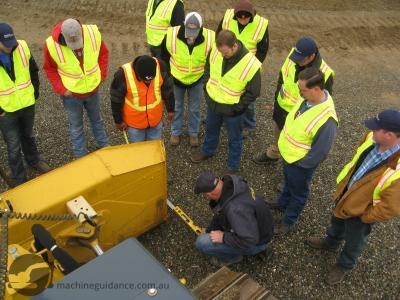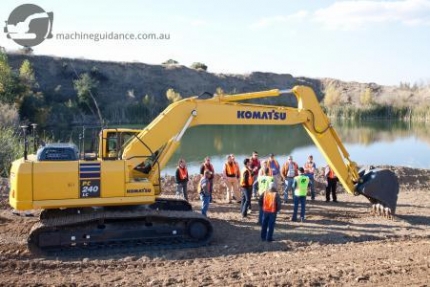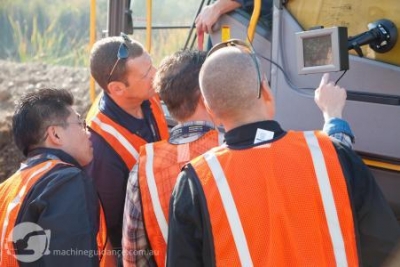Learning Never Stops
Machine guidance technologies are continuously being developed and refined to help improve construction productivity and efficiency. This article presents the case for training earthmovers in the age of technology.Published: May 2013
Author: Jack Lucic
Spare
1
1
If you thought that learning stopped on your last day of school, you're probably not reading this. Nope, those folks are still living in their parents' basement. Albert Einstein said it best: "Intellectual growth should commence at birth and cease only at death." Life is a learning experience.
The world demands more. To be successful a contractor needs to be current. In a world as rapid changing as the construction business, it's not surprising that the firms who survive and prosper are the ones who keep themselves current with new ideas and training. The expectations have changed. Contractors are expected to work harder, faster, and better... and within budgets where errors, re-work, and un-planned costs can eat up an already slim margin. To address these demands, construction contractors have turned to technology to help improve productivity, efficiency, and quality of the end result.
Earthmoving and paving contractors have learned that technology can be a tremendous tool in their success. Paper site plans and jobsites populated with wooden stakes are fast being replaced by 3D models and GPS machine control that can automatically govern heavy equipment to match the exacting details in a digital site plan. The technology is there and providers are continually refining and improving their products in an effort to make intuitive systems for site prep contractors to learn and use. The learning process never stops as the technology evolves.

Left Image

Right Image
2
2
"Just purchasing the technology is only half the battle," said Mark Contino, global vice president of product marketing, Topcon Positioning Systems, Livermore, Calif. "If customers don't have the level of training needed to fully understand and properly use this powerful technology they will never realize its full potential."
The major developers of earthmoving technologies have been providing contractor training for years. Initially, it was start-up and on-site training to assist machine operators, who were accustomed to operating equipment using their years of experience and "gut" feel.
These operators learned through training and demonstration to appreciate and allow the technology guiding the machine to help them complete their tasks in ways that are designed to be faster, better and easier.
With refined and newer technologies being developed, the innovative suppliers of site planning, site positioning systems, and GPS machine control technology are offering advanced training opportunities through large training events, boot camp style training courses, online tutorials (webinars), and specialized training programs at spacious, fully-equipped training facilities.
No matter what the tool is, there are increases in the efficiency and productivity that will be achieved with that tool after training on how to use it properly and, more importantly, to its fullest potential. When contractors invest in new technology, the first step is to properly train employees, so that they can know how to use and receive the most out of it.

3
3
As technology advances so, too, does the demand to make the learning and use of the technology as simple as possible. In many machine control systems and data management solutions, users can become fairly proficient with minimal training. Technology developed for more complex tasks using systems intended for multiple functions require more training in order to become proficient.
Providers have been refining their technology with each successive version, making them more and more user-friendly and enhancing the product's capabilities with every technological change. Easy-to-use machine control has evolved from giving single machine operators the ability to learn how to operate a technology-driven machine into data acquisition and field-office communication connectivity. This changes how contractors manage their businesses and decide what depth of training is required
Training helps the contractor and machine operator to take full advantage of technology. For example, machine control products are specifically designed to be simple to use, and for machine operators to become productive with basic functions with just a few hours of training. There are many features on the product that the operator may not know exist. They may not get the work done as efficiently as possible or realize the full potential of the technology without additional training.
"The key to contractor success is not just that one operator learns how to cut grade using machine control, but that the contractor's approach to business can improve dramatically if management embraces technology at every phase of the job," said John Dice, senior trainer, Topcon University, with Topcon Positioning Systems, Livermore, Calif. "To achieve full benefits of the machine control systems, training must be viewed as a prioritized company-wide initiative."
Instead of the foreman and grade setter laying out paper plans on the hood of a pickup truck, the job designs can now reside in electronic format that will be viewed on a computer screen in the job trailer, or a tablet in the pickup truck, or the survey rover's controller, or the machine control box, located in the operator cab.
How did the job design files get there? How does the contractor match the electronic job plans to GNSS position measurement? These systems are designed to minimize the amount of surveyor staking required on the job site, but without the stakes how can the grade setter verify that the grade was cut properly? What if they need to place a few reference stakes, but don't have the surveyor's hubs as reference?
The point is that machine control is designed to be a benefit to the contractor, to save time, to increase productivity and, simply, make more money. Since using it changes traditional methods of construction, every employee in every step of a job needs to understand how these new technologies work and how dramatically they can enhance every phase of every job. Employees have different tasks to make using the technology a success. Therefore, training becomes the catalyst forcing the different parts the contractor's organization to coordinate their efforts.

4
4
"Training needs to be planned ahead, and time for training needs to be scheduled," Dice said. "Too often, training is expected to take place during the construction operation. And, it is expected that it will not affect the existing daily operations. That's simply not reality for proper training."
There is also a qualitative difference between learning how to operate a new machine versus learning how to get the most out of a new technology. For instance, if a contractor purchases a new dozer, it is likely that an experienced dozer operator can be trained on the operation of the new machine with little impact on the daily schedule. But if the contractor purchases a new 3D machine control system, there may not be an experienced GPS machine control operator who could easily learn a new operating platform. On face value, technology, with its built-in "unknowns," can be intimidating.
"The benefits of thorough, enterprise-wide training can be seen immediately on job sites once the proper employees have been trained," Dice said. "GPS machine control is designed to provide three measurable benefits: increased productivity and efficiency, better control over import material quantities, and third, reduced survey staking costs-all of which can be documented."
Contractors receive much of their initial and ongoing training from the technology manufacturers' dealers who sold them the machine control systems. Since the equipment dealers often function as the primary source for contractor training, they are frequently the first to go through training programs developed by the manufacturer. It makes sense since the technology is evolving, changing, and receiving frequent updates, that a well-trained distributor network with a solid training program benefits the end-use.
For the contractor, the various training options available become critical to their success. Depending on the need, a contractor can participate in a variety of training options from self-paced online training to road show training to user conferences to webinars, and to complete classroom and/or outdoor training programs held at the technology developers' state-of-the-art facilities.
Most technology providers offer a formalized source and collection of advanced technology experts. The staff of experts can include licensed surveyors and seasoned machine control instructors with years of experience in the machine automation industry and familiarity with a variety of job sites.
Their education concepts typically include an extensive variety of learning options that may include self-directed, online learning, live webinars, instructor-led training courses, written product manuals and resource materials, guided software and firmware downloads, and formal instructor-led training programs held at local locations or at corporate training facilities.

Classroom Image
5
Credit
Based in Chicago, Jack Lucic is a freelance writer covering construction, management, and insurance topics. He can be reached at jacklucic@yahoo.com.
Return to Articles

